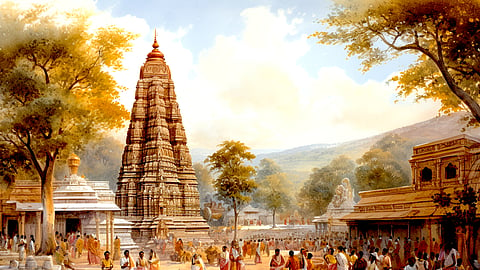- Commentary
- History Vignettes
- Notes on Culture
- Dispatches
- Podcasts
- Indian LanguagesIndian Languages
- Support

V.N. NARASIMHA IYENGAR SPENT THE NIGHT at Arakkonam and departed for Tirupati - Tirumala on 15 December 1872. The entry in his diary records the full details of his journey.
Read on!
15th December 1872, Started for Tirupati, after a hasty breakfast about 9-50 a.m.
The Iron Road pierces a wild and picturesque part of the country. The works are very costly, crossing numerous rivulets and streams which were all running more or less on account of the unusual floods of this year. Several huge rocks too were blasted and cut through to make way for the invincible iron-horse. The cultivation is more in valleys which alternate with the hills. Ragi and javari flourish as we approach Tirupati which is a large station....
We got into a bullock cart which would not go faster than about a mile an hour, notwithstanding the twisting of the tail of the bullocks. The heat was parching. After alternately walking and squatting in the cart for about three hours, we arrived at the town of Tirupati, which is about six and a half miles from the railway station.
The town is imbedded in a wide valley, enclosed by the Tirupati and Chandragiri ranges of hills, which are a continuation of the Eastern Ghats. It is tolerably clean find populous. The houses are almost all terrace-roofed and built with brick-in-chunam.
At the entrance, there is a Mari or Grama Devate temple. At the front of it, two huge stone figures of Sri Devi and Bhu Devi, wives of Vishnu, are placed opposite each other, and the road runs between them. These belonged, it appears, to a revived temple and Mr. J. D. Robinson, the Collector, had them placed where they are. They are nicely carved but the breasts are too disproportionate. They represent the goddesses unrobed in a sitting posture. There is a fine park in the town called the People’s Park founded by Robinson aforesaid. It is very gracefully planted with trees of all sorts, inclusive of the casuarina, and there is a small stream flowing through it from a small tank. There are good roads intersecting the town…
The chief attraction of the place is the temple of Govindarajaswami. It is a very spacious structure: the entrance is crowned with a stupendous spire or gopuram of seven stories, with brass kalasas at the summit. It is of brick and chunam work, profusely ornamented.
The road from the chief entrance to the second is lined on both sides by the houses of the temple officials and other smaller temples. Opposite the second gate, there is a very beautiful fountain fed from a nala or spring about two miles off. The central work is out of order, but the water overflows the four sides of the cistern all round the year. It is deep and square. All the people wash themselves and perform their rites on its margin, though no one is allowed to dip in his body or feet in the water. Much of the water runs to waste, creating a marsh in the neighbourhood...
The temple seems to be a cluster of buildings of several classes and ages. Part of it is in disrepair and part under restoration. It cannot lay much claim to architectural beauty, excepting in the matter of a few stone pillars and a stone mantapam. The former are well carved, and divided into four sides, three being rounded and forming smaller pillars, and the fourth cut into a horse or lion rampant, the whole being a single block. There are a great many of these pillars in the temples. The mantapam is a most richly carved pavilion about twelve feet square, wrought out of gneiss. It is installed in a spacious court to the right of the principal idol.
Owing to the vandalism of the temple people, it is completely covered by a thick coat of filth, very tough and ages old. The whole of the cluster of buildings up to the second gate forms a square which is fortified by substantial grey granite walls. The internal and external walls are built of slabs (some being of black stone) which are covered with inscriptions in Grantham, Tamil and Telugu. No one seems to have deciphered them.
Here the people are Telugu, and their manners and customs have a tinge of those of Madras.
About two miles from the town of Tirupati in a northerly direction is a picturesque waterfall called Kapila Teertham. A volume of water falls from a height about six feet from the summit of one of the Tirupati range of hills. The cataract falls into a large stone-faced oblong pond which is surrounded on three sides by several mantaps and temples. It is a very romantic spot, near enough to the town to be reached by a wholesome walk and yet far enough not to be defiled by the people.
The sight of the town in the moonlight is very charming. Mr. J. D. Robinson has shown much taste and skill in the laying out of the Park. There are several idols placed at the angles of the roads which pass through it, taken from the ruined temple aforesaid. One was a very large sleeping figure of Ranganatha very nicely carved, though not richly. There is a huge stone serpent with five heads and the hood extended. It is about six feet high.
Iron Road: Railway track
Iron-horse: Train
Javari: Jowar
Chunam work: Limestone used in construction
Govindrarajaswami Temple: The town of Tirupati was built around it. It was clearly in a pathetic state when Narasimha Iyengar visited it.
To be Continued
The Dharma Dispatch is now available on Telegram! For original and insightful narratives on Indian Culture and History, subscribe to us on Telegram.
